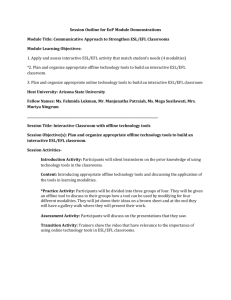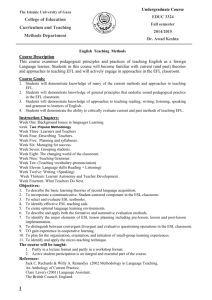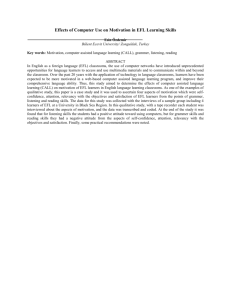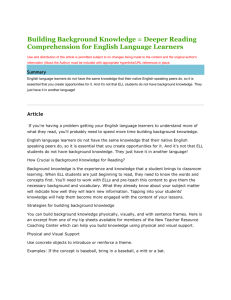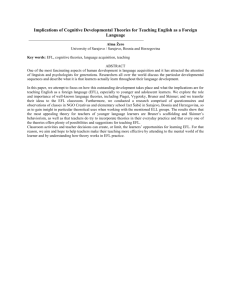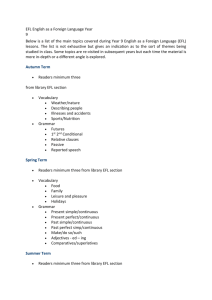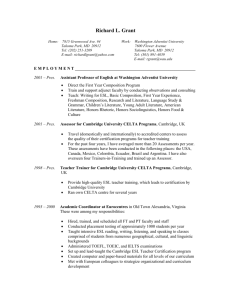thaistudentneeds
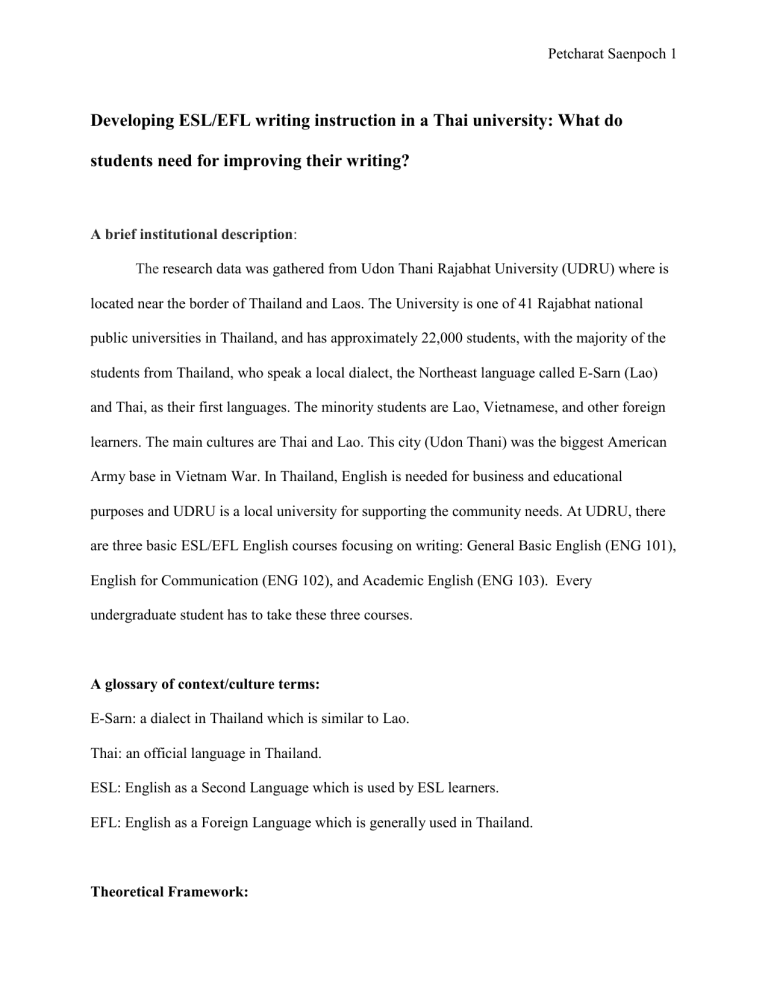
Petcharat Saenpoch 1
Developing ESL/EFL writing instruction in a Thai university: What do students need for improving their writing?
A brief institutional description :
The research data was gathered from Udon Thani Rajabhat University (UDRU) where is located near the border of Thailand and Laos. The University is one of 41 Rajabhat national public universities in Thailand, and has approximately 22,000 students, with the majority of the students from Thailand, who speak a local dialect, the Northeast language called E-Sarn (Lao) and Thai, as their first languages. The minority students are Lao, Vietnamese, and other foreign learners. The main cultures are Thai and Lao. This city (Udon Thani) was the biggest American
Army base in Vietnam War. In Thailand, English is needed for business and educational purposes and UDRU is a local university for supporting the community needs. At UDRU, there are three basic ESL/EFL English courses focusing on writing: General Basic English (ENG 101),
English for Communication (ENG 102), and Academic English (ENG 103). Every undergraduate student has to take these three courses.
A glossary of context/culture terms:
E-Sarn: a dialect in Thailand which is similar to Lao.
Thai: an official language in Thailand.
ESL: English as a Second Language which is used by ESL learners.
EFL: English as a Foreign Language which is generally used in Thailand.
Theoretical Framework:
Petcharat Saenpoch 2
Needs Analysis
Celce-Murcia (2001) stated that a needs analysis is an assessment of the communicative needs of a learner. Richards (1984) mentioned that a needs analysis is an activity for designing and implementing a language program; developing goals, objectives, and contents; and reviewing and evaluating an existing program. Munby (1978) indicated that a needs analysis primarily involves learners’ backgrounds.
Communicative Approach
Celce-Murcia (2001) points out that a communicative approach is a teaching methodology focusing on communication and it can help teachers and learners accomplish goals of teaching and learning in ESL/EFL educational settings.
Student-Centered Approach
Walker and Soltis (2004) indicate that a student- centered approach is a style of teaching that focuses on learners and this approach can help students improve their English skills in ESL/EFL classes.
Developing ESL/EFL writing instruction in a Thai university: What do students need for improving their writing?
English is one of the major foci for educational development at Udon Thani Rajabhat University
(UDRU) where is located in the northeastern part of Thailand. However, English instruction is rarely developed and I, as an English lecture at UDRU, have found some problems in English classes. For instance, students are inactive in learning English and the ESL/EFL instructors only focus on a traditional style of teaching (a teacher-centered approach). Additionally, the class size is very large (50-150
Petcharat Saenpoch 3 students/class). Therefore, I would like to use my research for improving ESL/EFL writing instruction at a college level. Briefly, these four sections will be included in the study:
Section I: Introduction.
Section II: Discussions.
Section III: Recommendations.
Section IV: Conclusion.
These are more details of each section in this study:
Section I: Introduction
What is a Needs Analysis?
• Celce-Murcia (2001) stated that a needs analysis is an assessment of the communicative needs of a learner.
• Richards (1984) mentioned that a needs analysis is an activity for designing and implementing a language program; developing goals, objectives, and contents; and reviewing and evaluating an existing program.
• Munby (1978) indicated that a needs analysis primarily involves learners’ backgrounds.
Why is a Needs Analysis Important?
• Celce-Murcia (2001) pointed out that assessing the needs of students is important for curriculum development.
• Savignon (1972) demonstrated that identifying the learners’ needs is the first step in the teaching development.
• West (1994) showed that a needs analysis is an essential activity for language curriculum.
• McDonough (1984) revealed that learners’ needs are keys for developing curriculum.
Petcharat Saenpoch 4
Examples of a Needs Analysis Project
• Basturkmen (1998) presented that a needs analysis was a primary resource for developing curriculum at The English Language Unit at Kuwait University.
• Maggard (1997) indicated that a needs analysis could improve a language program at
The Intensive English Language Program at Portland State University.
• Kuter (1999) showed that a needs analysis project focused on syllabus designs, instructional materials, and effective instructions for improving a language program at Eastern
Mediterranean University.
• Brindley (1984) illustrated that a needs analysis was used for improving ESL curriculum at the Adult Migrant Education Service in Australia.
• Valdez (1999) pointed out that a needs analysis emphasized the language proficiency, the learning preferences, and the purposes for learning the second language and they were used for English class development at Bukidnon State College in the Philippines.
• Garip and Perkan (1999) reported that the library and translation skills were basic students’ needs and they were used for improving courses at The Service Unit of English
Language Teaching Department at Eastern Mediterranean University.
Communicative Approach
• Celce-Murcia (2001) points out that a communicative approach is a teaching methodology focusing on communication and it can help teachers and learners accomplish goals of teaching and learning in ESL/EFL educational settings.
Student-Centered Approach
Petcharat Saenpoch 5
• Walker and Soltis (2004) indicate that a student- centered approach is a style of teaching that focuses on learners and this approach can help students improve their English skills in ESL/EFL classes.
Section II: Discussions
1) Course Sequence
The students have English backgrounds.
The students have experiences in using English.
The order of English course preparation is not in order.
2) Varying Emphasis on English skills
The balance of all four English skills is needed.
The students need English for studies and careers.
3) Teacher Pedagogy
The lecture as a single approach or passive teaching style is mostly used.
The interaction between the lectures and listeners is ignored.
The students infrequently have any responses.
4) Importance of Learner Input or Opinions
Teachers need to bring in student input and opinions when designing or developing English courses.
Concerning students’ opinions is ignored.
Letting students express views is unobserved.
5) Use of Thai in English Class (Thai Lecture)
The teachers frequently use Thai in English classes.
The learners want to study with English native speakers.
Petcharat Saenpoch 6
Why do teachers mostly use Thai for teaching English?
6) Classroom Size
Why are small classes better than large classes?
Effect on Instruction and Class Management
- Krieger (2003) addressed that teachers in small-size classes spend less time on classroom management.
- Halbach, Ehrle, Zahorik and Molnar (2001) found that smaller classes spend
more time for instruction and individualization.
- Zahorik (1999) showed that smaller classes had fewer discipline problems.
Effect on Academic Achievement
- Dillon, Kokkelenberg and Christy (2002) demonstrated that the students' GPA declines as the class size increases.
Effect on Attitude
- Glass and Down (1979) identified that smaller classes increase student achievement and improve school attitudes.
- Smith and Glass (1979) described that small class size is associated with higher quality classroom environments, better student attitudes, and greater teacher satisfaction.
The Optimal Class Size
- Goettler-Sopko (1990) mentioned that no single class size is best but smaller class
sizes seem to result in higher achievement.
Class Size Reduction Funds
- Naik and Uro (2000) reported that class size reduction funds are useful for recruiting more teachers, providing professional development, and improving student achievement.
Section III: Recommendations
1.
The order of the EFL course preparation needs to be structured.
Petcharat Saenpoch 7
(Basic English (101), English for Communication (102), and Academic English (103))
2.
All English skills should have equal emphasis.
3.
Diverse teaching approaches, methods, and strategies should be added in English classes.
4.
Student perception of needs should be considered when English courses are developed.
5.
Use of Thai in English class should be concerned.
6.
Efforts to reduce class size should be taken seriously (Al-Jarf, 2006).
Section IV: Conclusion
There are six major concerns in this study:
1) Course Sequence
2) Varying Emphasis on English skills
3) Teacher Pedagogy
4) Importance of Learner Input or Opinions
5) Use of Thai in English Class
6) Classroom Size
These six significant concerns should be considered when English curriculum is developed. Importantly, this study will hopefully be helpful and effective for improving
ESL/EFL instruction, increasing ESL/EFL students’ English skills, and promoting ESL/EFL students’ learning (Saenpoch, 2006).
Petcharat Saenpoch 8
References
Al-Jarf, M. (2006). Large Student Enrollments in EFL Programs: Challenges and Consequences.
Retrieved January 13, 2011, from http://www.asian-efl-journal.com/Dec_06_raj.php
Basturkmen, H. (1998, October - November). Refining procedures a needs analysis
project at Kuwait University. Forum , 36 (4), p.2. Retrieved November 24, 2008,
from http://exchanges.state.gov/forum/vols/vol36/no4/p2htm#special_ret_102
Petcharat Saenpoch 9
Brindley, G. (1984). Needs Analysis and Objective Setting in The Adults Migrant
Educational Program.
Sydney: NSW Adult Migrant Education Service.
Celce-Murcia, M. (Ed.). (2001).
Teaching English as a Second or Foreign Language
(3 rd
Ed.).
Boston: Heinle & Heinle.
Dillon, M., Kokkelenberg, E. & Christy, S. (2002). The Effects of Class Size on Student
Achievement in Higher Education: Applying an Earnings Function. ERIC Document
Reproduction Service No. ED482389.
Garip, N. & Perkan, C. (1999). An Academic Needs Analysis of EFL Learners.
Retrieved November 25, 2008, from
http://sfl.emu.edu.tr/tu/oldconferences/confarchive/ASCPnucangarip.htm
Glass, G. V. & Down, A. G. (1979). Does class size make a difference? Instructor , 89 (4), 22.
Goettler-Sopko, S. (1990). The effect of class size on reading achievement. ERIC Document
Reproduction Service No. ED325826.
Halbach, A.; Ehrle, K.; Zahorik, J. & Molnar, A. (2001). Class size reduction: From promise to
practice. Educational Leadership , 58 (6), 32-35.
Krieger, J. (2003). Class size reduction: Implementation and solutions. ERIC Document
Reproduction Service No. ED475489.
Kuter, S. (1999). An Academic English Needs Analysis in EFL Classrooms.
Retrieved November 23, 2008, from
http://sfl.emu.edu.tr/tu/oldconferences/confarchive/ASCPSitkiyeKuter.htm
Maggard, J. (1997). Needs Analysis at Portland State University. Retrieved November 25,
Petcharat Saenpoch 10
2008, from http://www.miyazaki-mic.ac.jp/faculty/jmaggard/needs.htm
McDonough, J. (1984). ESP in Perspective: A Practical Guide . London: Collins.
Munby, J. (1978). Communicative Syllabus Design . Cambridge: Cambridge University
Press.
Naik, C. M. & Uro, G. (2000). Reducing class size: A smart way to improve America's urban
schools. ERIC Document Reproduction Service No. ED447228.
Richards, J. (1984). Language Curriculum Development. RELC Journal , 15 (1).
Saenpoch, P. (2006). An Exploration of the Perception of Thai College Students toward
Instruction in English as a Foreign Language in Thailand . University of Hawaii at Manoa.
Savignon, S.J. (1972). Communicative competence: an experiment in foreign language
teaching . Philadelphia, PA: Center for Curriculum Development.
Smith, M. L. & Glass, G. V. (1979). Relationship of class-size to classroom processes, teacher
satisfaction and pupil affect: A meta-analysis. ERIC Document Reproduction Service No.
ED190698.
Valdez, M.G. (1999, January - March). How learners’ needs affect syllabus design.
Forum , 37 (1), p. 30. Retrieved November 26, 2008, from
http://exchanges.state.gov/forum/vols/vol37/no1/p30.htm
Walker, D.F. & Soltis, J.F. (4 th Ed.). (2004). Curriculum and Aims . New York:
Teachers College Press.
West, R. (1994). Need analysis in language teaching. Language Teaching . Cambridge:
Cambridge University Press, p.1-19.
Zahorik, J. A. (1999). Reducing class size leads to individualized instruction. Educational
Leadership , 57(1), 50-53.
Petcharat Saenpoch 11


